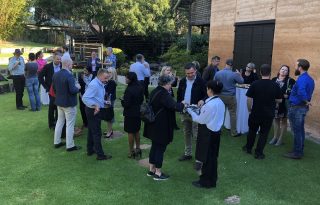Last week I attended the Rangelands Natural Resource Management (NRM) Annual General Meeting and their showcase and sundowner. The theme was about celebrating the past three years of work by getting their partners to “share their stories of NRM successes and what the land, their rangelands means to them”.
The whole NRM community has been on a really exciting (and somewhat terrifying) ride over the last twelve-odd months with the massive changes that the Federal Government’s Regional Land Partnership funding has brought down upon on that community. The main change – moving to a competitive model – has been a major psychological shift for the community. This hasn’t been easy for many of the NRM groups that we continue to support, so it was great to have a moment to look back at all the good work that one of them (that manages over 85% of the State of Western Australia) has managed to achieve.

A great part of the event was networking in the Japanese Gardens at the Perth Zoo (courtesy: Rangelands NRM)
The partners who presented really did represent the broad spectrum of organisations that an NRM group works with, including:
- The Pilbara Mesquite management Committee – a non=profit regional collaboration group, controlling mesquite (Prosopis species) and other Weeds of National Significance,
- Carey Downs Station – a quite visionary pastoral property that is working with Rangelands NRM to implement best practices for land management – while maintaining a focus on sustainability
- Ten Deserts Project – a collaboration of indigenous groups that is preserving knowledge of fire regimes, supporting and empowering indigenous groups and taking collective actions to build environmental resilience,
- Roebuck Bay Working Group – a great project that has been supported for some time by Rangelands NRM that works to collaboratively educate, conduct research and get the community involved in this important Ramsar listed area, and
- Spinifex Land Management – an indigenous non-profit group that, apart from cleaning up at the awards they’re nominated for (they won the 2018 National Landcare Award for Indigenous Land Management), also have one rockin’ band and a great video (which I can’t find online).
The resounding theme from my notes was the partners all thought of Rangelands NRM as the “glue” which holds them together, or as facilitators that enable them to get things done, or put them in touch with the right people. This is a really valuable, independent service that is often overlooked by funding bodies who are looking for more traditional returns on their funding investment.
The role that the NRM regions play in glueing these groups together, and enabling them to become more successful, is something that we see a lot of – and that’s a big reason as to why we support the NRM community here. Our approach has been similar to the one I saw so clearly and repeatedly articulated at the celebration – we also try to join groups up and provide more holistic, collaborative services, like we have done with the GRID product, or making our QGIS training course freely available in an online format.
The foreword from our QGIS video series, explaining why we produced it
Now that the dust is settling on the Regional Land Partnership programs, we’re going to be back out there, trying to find even more ways that we can collaborate and provide support to the NRM community. We’ve got a few ideas around sharing resources, developing more tools for common use and with potential projects already lining up, I’m hoping there will be a lot more in this space to blog about in the near future. But throughout, we’re trying to emulate Rangelands NRM’s commitment to collaboration, and “be the glue” for the NRM community.
In the meantime, if you are an NRM group, or a Landcare organisation, and you’re struggling with technology, then please feel free to give us a call and have a chat about what we can do to help. We like nothing more than a chinwag about technology problems, and can also be found on Facebook, Twitter or LinkedIn – or drop me a line on (08) 9227 7309 or at piers@gaiaresources.com.au.
Piers

Comments are closed.